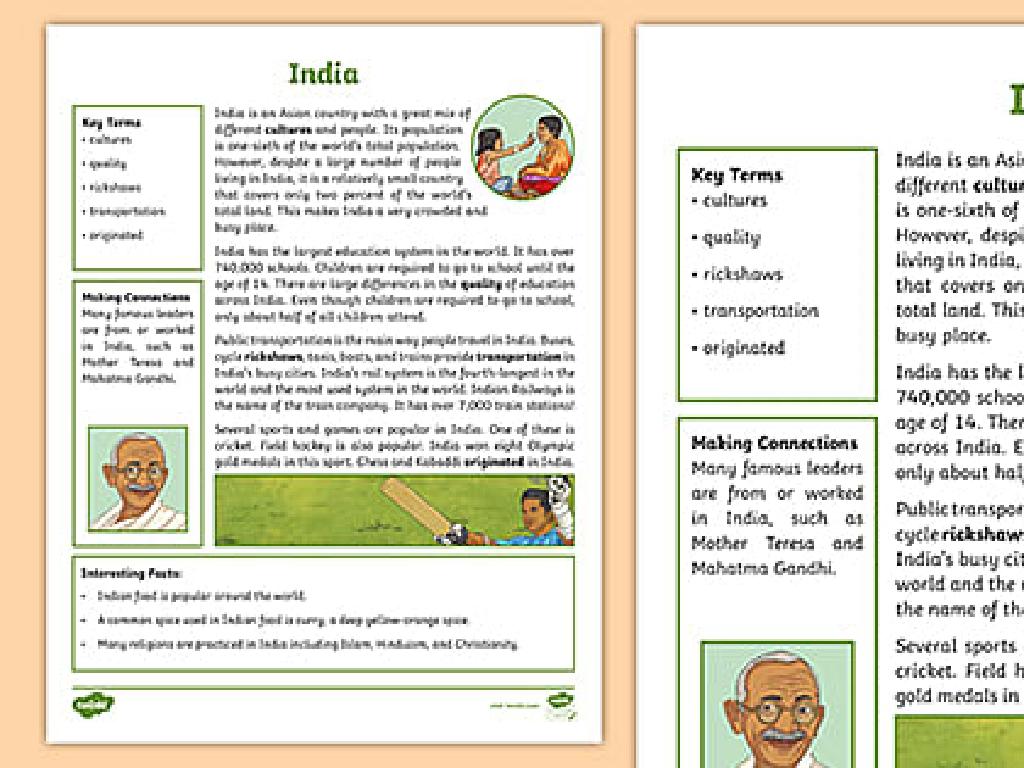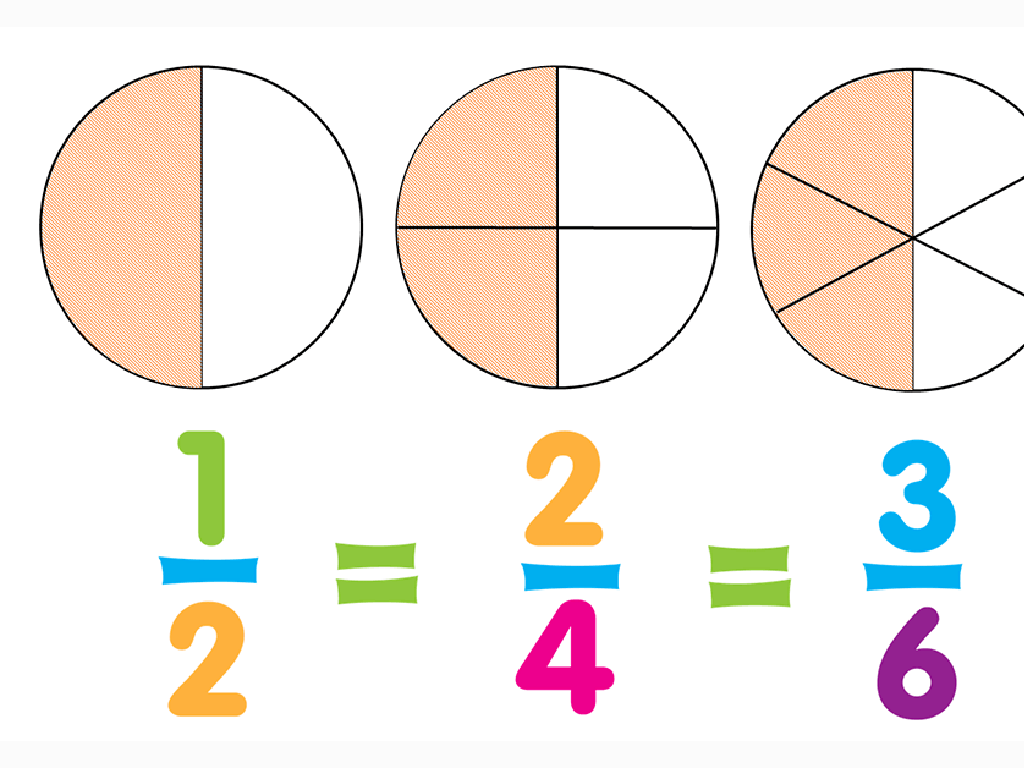Global Cultures 1980 Now
Subject: Arts and humanities
Grade: High school
Topic: Art History
Please LOG IN to download the presentation. Access is available to registered users only.
View More Content
Global Cultures in Contemporary Art
– Art within a global context
– How art reflects and influences global interactions
– Worldwide cultural contributions
– Examples: African sculptures, Japanese anime, and graffiti in urban America
– Diversity’s role in art
– Diversity enriches art, leading to new styles and ideas
– Embracing global art perspectives
|
This slide introduces students to the concept of global cultures and their influence on contemporary art since the 1980s. It’s crucial to convey that art is not created in a vacuum but is a reflection of the interconnected world we live in. Highlight how different cultures contribute unique perspectives and styles to the global art scene, such as the influence of African art on modern sculpture or the worldwide popularity of Japanese anime. Discuss the importance of diversity in art, which fosters creativity and innovation by bringing together a multitude of voices and experiences. Encourage students to think about how embracing different cultural perspectives can lead to a richer understanding of art and its role in society.
The 1980s Art Scene: A Cultural Renaissance
– Key artists and movements
– Explore artists like Basquiat, movements like Neo-Expressionism
– Art shaped by politics and society
– Art as a response to events like the fall of the Berlin Wall
– Emergence of street art
– Street art as a form of public expression and activism
– Graffiti’s impact on culture
– Graffiti transcends vandalism to become recognized art form
|
This slide delves into the dynamic art scene of the 1980s, highlighting influential artists and movements such as Jean-Michel Basquiat and Neo-Expressionism. It also examines how political and social events, including the Cold War’s climax and the fall of the Berlin Wall, shaped artistic expression during this period. The rise of street art and graffiti as significant cultural phenomena is explored, noting their evolution from underground subcultures to respected and influential art forms. Encourage students to consider the ways in which art reflects and influences the zeitgeist of its time and to discuss the lasting impact of 1980s art on contemporary culture.
Art and Technology: The Digital Revolution
– Impact of digital revolution on art
– Shift from traditional to digital art platforms, e.g., digital painting, 3D printing
– Exploring new media art forms
– Interactive installations, digital sculpture, and video art as examples of new media
– Technology’s role in global art reach
– Social media and the internet bridging artists and audiences worldwide
– Case studies of tech in art
– Analyze examples like VR art exhibits and online galleries
|
This slide aims to explore the intersection of art and technology, focusing on how the digital revolution has transformed artistic expression and dissemination. Highlight the transition from traditional art forms to digital platforms, which has allowed for innovative techniques like digital painting and 3D printing. Discuss new media art forms, including interactive installations and video art, which have emerged with technological advancements. Emphasize how technology, especially the internet and social media, has expanded the reach of artists, allowing them to connect with global audiences. Use case studies to illustrate the practical application of technology in art, such as virtual reality art exhibits and the proliferation of online galleries. Encourage students to think critically about the implications of these changes for the future of art.
Cultural Fusion in Contemporary Art
– Cross-cultural influences in art
– Artworks blending Eastern and Western aesthetics, like Ai Weiwei’s sculptures
– Globalization’s impact on art
– Globalization allows for the exchange of artistic ideas across borders
– Artists with multicultural inspirations
– Frida Kahlo combined Mexican and European styles in her paintings
– Embracing diversity through art
|
This slide explores the concept of cultural fusion in art, highlighting how contemporary artists incorporate elements from different cultural backgrounds into their work. Discuss examples like Ai Weiwei, who merges traditional Chinese craftsmanship with modern themes. Explain how globalization facilitates the sharing of artistic techniques and narratives, leading to a richer, more diverse art world. Highlight artists like Frida Kahlo, who are celebrated for their ability to represent their complex cultural identities in their art. Encourage students to think about how art can transcend cultural boundaries and reflect the interconnectedness of our global society.
Art as Social Commentary
– Artists responding to society
– Explore how artists express their views on social and political issues through their work.
– Art’s role in conversation and change
– Discuss how art can initiate discussions and inspire societal shifts.
– Examining case studies of impactful art
– Analyze specific artworks that have made significant impacts on society.
– Understanding art’s influence on politics
– Learn how political movements and events are reflected and affected by art.
|
This slide delves into the role of art as a medium for social and political commentary. It will explore how artists use their creations to respond to and reflect upon contemporary issues, sparking conversation and potentially driving change. Students will examine case studies of artworks that have had a profound impact on society, such as Banksy’s street art or Ai Weiwei’s installations. The discussion will also cover how art can influence and be influenced by political movements, serving as a catalyst for public discourse and action. Encourage students to think critically about the messages conveyed through art and to consider the power of visual expression in shaping societal values and norms.
Contemporary Art Movements and Global Culture
– Overview of current art movements
– Explore movements like Street Art, Digital Art, and Eco Art
– Movements as cultural reflections
– How art captures societal values, issues, and identities
– Art in today’s globalized context
– The impact of technology and communication on art
– Predicting the future of art
– Considerations on how art will evolve with cultural shifts
|
This slide aims to provide students with an understanding of how contemporary art movements are both influenced by and reflective of our global culture. It’s important to highlight specific art movements that have emerged in recent years, such as Street Art, which often tackles social and political issues, Digital Art, which has been propelled by technological advancements, and Eco Art, which responds to environmental concerns. Discuss how these movements offer insights into the values, issues, and identities that shape society today. Additionally, consider the role of technology and global communication in spreading art and ideas, leading to a more interconnected art world. Encourage students to think critically about how current trends might shape the future of art and how art can continue to be a powerful tool for expressing global culture.
Class Activity: Creating Global Art
– Create artwork inspired by another culture
– Utilize cultural materials and techniques
– For example, use Japanese ink painting methods or Aboriginal dot painting techniques
– Share and explain your artwork
– Discuss the elements of the culture represented in your art
– Reflect on the cultural learning
– How did this activity enhance your understanding of the culture?
|
This class activity is designed to immerse students in the study of global cultures through art. Students are encouraged to research and select a culture distinctly different from their own and create an original piece of art that reflects that culture’s artistic traditions. They should consider using materials and techniques specific to the culture they have chosen. Upon completion, students will share their artwork with the class and explain the cultural elements they incorporated, such as symbols, techniques, or themes. This activity promotes cultural appreciation and awareness. Possible variations include group projects, multimedia presentations, or written reflections to accompany the artwork. The goal is for students to engage with and respect cultural diversity through artistic expression.






